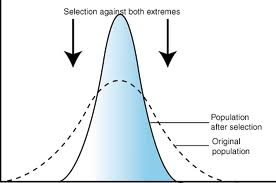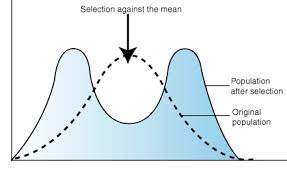It looks like you're using an Ad Blocker.
Please white-list or disable AboveTopSecret.com in your ad-blocking tool.
Thank you.
Some features of ATS will be disabled while you continue to use an ad-blocker.
2
share:
Evolution is a theory that explains the origin of life as we know it. While it is commonly referred to as "just a theory", it is important to
remember, in science terms, a theory is overwhelmingly backed up by evidence and observation.
Evolution is usually the result of selection pressures. Biological evolution is genetic change in a population between generations. This is where an adaptation is made to suit a changing environment. Selection pressures lead to a certain characteristic being selected for and therefore becoming more frequent in a population. Different types of selections are:

Stabilising selection - This is when the most popular phenotype are selected for and he extremes of the population are selected against. An analogy would be beak size. Large and small beaks may be selected against while the mean beak size will be selected for. Think of this in terms of a bell curve.

Directional selection - This is where a certain direction is taken in selection. Usually, this means an extreme will be selected for, and one extreme will be selected against. This cause the most frequent phenotypes to become the extreme, an extreme to become the most popular, and a new extreme to arise, as the survival chance of ''an ever larger beak" increases. i.e the allele frequency shifts in one direction.

Disruptive selection - This is where the extremes are selected for simultaneously and the most common phenotypes are selected against. This could be the result of a pathogen or extreme environmental conditions.

For all selections, the fittest individuals survive and pass in their genes more often than those who have worse survival chances.
You may hear the terms adaptive radiation, divergent evolution, convergent evolution, gradualism and punctuated equilibrium.
Divergent evolution refers to a single common ancestor, diverging into two or more species.
Adaptive radiation refers to a burst of divergent evolution where many different species evolve from a common ancestor to suit a variety of different ecological roles.
Convergent evolution: This is an important concept to understand and I believe confuses a few people. This is where species which are considered very distantly related or not related at all, have evolved similar adaptions to overcome a common problem. They both occupy similar environments and have similar tasks (niches).
Gradualism is a type of evolution in which there is a slow constant change in a species over time.
Punctuated equilibrium is also a type of evolution, but this is where there are long periods of little evolutionary change followed by small periods of rapid speciation.
The claims in evolution are all accounted for by the use of fossils, genetic similarity, mitochondrial DNA, Y chromosome DNA, biogeography, comparative anatomy.
I'm sure there will be some questions, so feel free to ask and I will answer them as best I can.
Evolution is usually the result of selection pressures. Biological evolution is genetic change in a population between generations. This is where an adaptation is made to suit a changing environment. Selection pressures lead to a certain characteristic being selected for and therefore becoming more frequent in a population. Different types of selections are:

Stabilising selection - This is when the most popular phenotype are selected for and he extremes of the population are selected against. An analogy would be beak size. Large and small beaks may be selected against while the mean beak size will be selected for. Think of this in terms of a bell curve.

Directional selection - This is where a certain direction is taken in selection. Usually, this means an extreme will be selected for, and one extreme will be selected against. This cause the most frequent phenotypes to become the extreme, an extreme to become the most popular, and a new extreme to arise, as the survival chance of ''an ever larger beak" increases. i.e the allele frequency shifts in one direction.

Disruptive selection - This is where the extremes are selected for simultaneously and the most common phenotypes are selected against. This could be the result of a pathogen or extreme environmental conditions.

For all selections, the fittest individuals survive and pass in their genes more often than those who have worse survival chances.
You may hear the terms adaptive radiation, divergent evolution, convergent evolution, gradualism and punctuated equilibrium.
Divergent evolution refers to a single common ancestor, diverging into two or more species.
Adaptive radiation refers to a burst of divergent evolution where many different species evolve from a common ancestor to suit a variety of different ecological roles.
Convergent evolution: This is an important concept to understand and I believe confuses a few people. This is where species which are considered very distantly related or not related at all, have evolved similar adaptions to overcome a common problem. They both occupy similar environments and have similar tasks (niches).
Gradualism is a type of evolution in which there is a slow constant change in a species over time.
Punctuated equilibrium is also a type of evolution, but this is where there are long periods of little evolutionary change followed by small periods of rapid speciation.
The claims in evolution are all accounted for by the use of fossils, genetic similarity, mitochondrial DNA, Y chromosome DNA, biogeography, comparative anatomy.
I'm sure there will be some questions, so feel free to ask and I will answer them as best I can.
edit on 3-10-2013 by curiousrb because: (no reason given)
in progress. pressed enter.....
Now THIS is something I can get on board with.
reply to post by six67seven
You have to realize I'm making sure these definitions are understandable to all those who wish to take a look at evolution.
I can go on to talk about the specifics of speciation, isolating mechanisms (allopatric, sympatric- pre and post zygotic), polyploidy, population effects, genetic variation, mutation, no disjunction and specifically human evolution if you like?
However the thread was titled as fundamental for a reason.
You have to realize I'm making sure these definitions are understandable to all those who wish to take a look at evolution.
I can go on to talk about the specifics of speciation, isolating mechanisms (allopatric, sympatric- pre and post zygotic), polyploidy, population effects, genetic variation, mutation, no disjunction and specifically human evolution if you like?
However the thread was titled as fundamental for a reason.
new topics
-
Sorry to disappoint you but...
US Political Madness: 1 hours ago -
Watch as a 12 million years old Crab Emerges from a Rock
Ancient & Lost Civilizations: 6 hours ago
2
